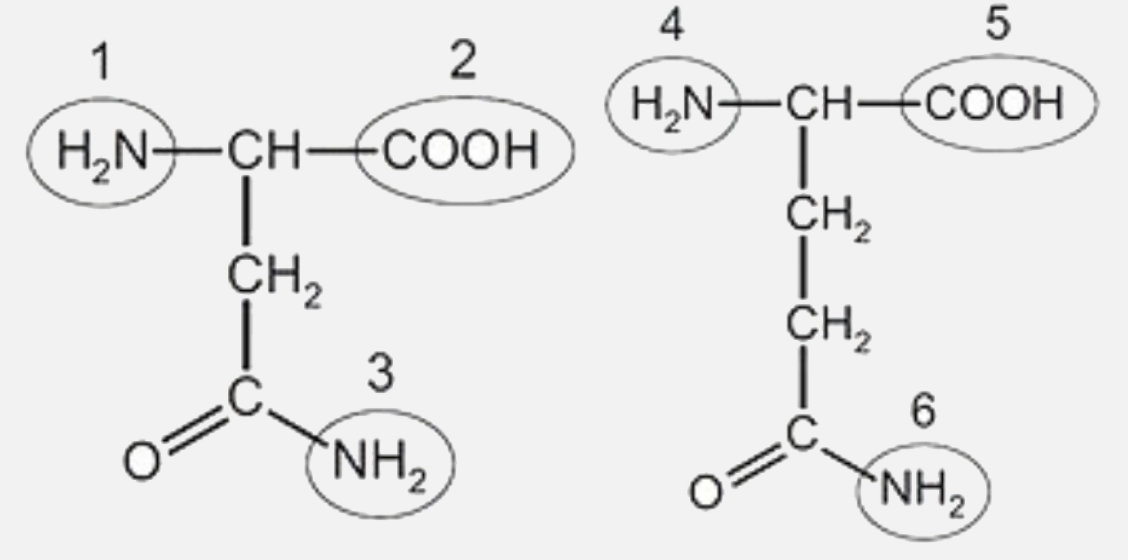Peptide bond is a key feature in:
Polysaccharide
Proteins
Nucleotide
Vitamins
The correct Answer is:B
To solve the question "Peptide bond is a key feature in:", we need to analyze the options provided: polysaccharide, proteins, nucleotides, and vitamins.
1. Understanding Peptide Bonds:
- A peptide bond is a type of covalent bond that links amino acids together in proteins. It is formed through a condensation reaction where the carboxyl group of one amino acid reacts with the amino group of another, releasing a molecule of water.
2. Analyzing the Options:
- Polysaccharides: These are carbohydrates made up of sugar units linked by glycosidic bonds, not peptide bonds. Examples include starch and cellulose.
- Proteins: Proteins are polymers made up of amino acids linked by peptide bonds. This is the correct answer.
- Nucleotides: Nucleotides are the building blocks of nucleic acids (DNA and RNA) and are linked by phosphodiester bonds, not peptide bonds.
- Vitamins: Vitamins are organic compounds that are essential in small amounts for various biochemical functions. They do not contain peptide bonds.
3. Conclusion:
- Since peptide bonds are specifically associated with proteins, the correct answer to the question is proteins.
Final Answer:
Peptide bond is a key feature in proteins.
---
- A peptide bond is a type of covalent bond that links amino acids together in proteins. It is formed through a condensation reaction where the carboxyl group of one amino acid reacts with the amino group of another, releasing a molecule of water.
- Polysaccharides: These are carbohydrates made up of sugar units linked by glycosidic bonds, not peptide bonds. Examples include starch and cellulose.
- Proteins: Proteins are polymers made up of amino acids linked by peptide bonds. This is the correct answer.
- Nucleotides: Nucleotides are the building blocks of nucleic acids (DNA and RNA) and are linked by phosphodiester bonds, not peptide bonds.
- Vitamins: Vitamins are organic compounds that are essential in small amounts for various biochemical functions. They do not contain peptide bonds.
- Since peptide bonds are specifically associated with proteins, the correct answer to the question is proteins.
Peptide bond is a key feature in proteins.
Topper's Solved these Questions
- SYNTHETIC AND NATURAL POLYMERSBOOK - CENGAGE CHEMISTRY ENGLISHCHAPTER - SYNTHETIC AND NATURAL POLYMERSEXERCISE - Exercises Assertion Reasoning
10 Videos
- SYNTHETIC AND NATURAL POLYMERSBOOK - CENGAGE CHEMISTRY ENGLISHCHAPTER - SYNTHETIC AND NATURAL POLYMERSEXERCISE - Exercises Multiple Correct
28 Videos
- SURFACE CHEMISTRYBOOK - CENGAGE CHEMISTRY ENGLISHCHAPTER - SURFACE CHEMISTRYEXERCISE - Archives Subjective
2 Videos
Similar Questions
Knowledge Check
During chain elongation, peptide bond is formed between carboxyl group of first and amino group of second amino acid by
APeptidyl transferaseBTaq polymeraseCDNA ligaseDHelicase
Peptide bonds are formed between which group of amino acids?
View SolutionPeptide bond is formed between two amino acids through
View SolutionDefine the following term in relation to proteins :
(i) Peptide bond
(ii) Denaturation of proteins.
View Solution[A] : Peptide bonds are present in primary , secondary & tertiary structures of proteins .
[R] : All structures of protein contain amino acids .
View SolutionPeptide linkage is
View SolutionWhich of these is not a key feature of meiosis
View SolutionThe diagrams show the structures of two amino acids, each of which has two amine (−NH2) Group .

A peptide bond is formed between the two amino acids. Which groups could from the peptide bond ?
View Solution
